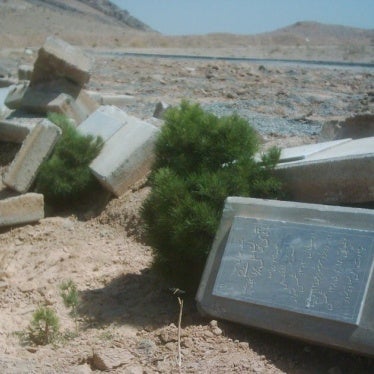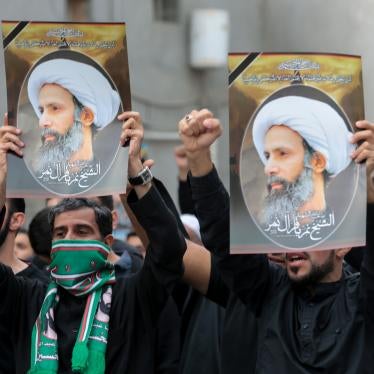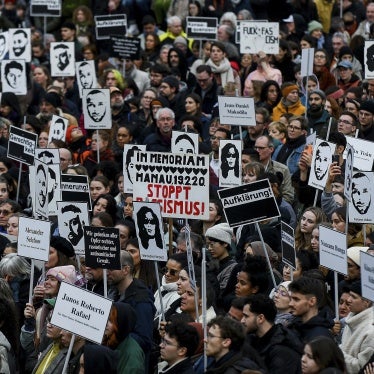The Hamas-run government in Gaza must establish an independent and nonpartisan commission of inquiry to hold security forces accountable for their use of excessive and indiscriminate force against pro-Fatah demonstrators in Gaza City on Monday, Human Rights Watch said today. More than 90 demonstrators were wounded and seven lost their lives when Hamas security forces opened fire.
In a speech on Thursday, Hamas leader Ismail Haniya announced the creation of an “honest, fair and transparent” commission to investigate Monday’s violence. He also ordered the release of Fatah members and supporters arrested after the demonstration, except for those “involved in riots and disturbances.”
“We welcome a commission of inquiry, but it must be truly independent with respected, nonpartisan members,” said Sarah Leah Whitson, Middle East director at Human Rights Watch. “The investigation must lead to the prosecution of any members of the security forces or Fatah members who broke the law.”
Human Rights Watch interviewed three shooting victims from the demonstration and five eyewitnesses, as well as hospital, health ministry and interior ministry officials in Gaza. The testimony reveals that Hamas security forces, which at times came under attack from stone-throwing demonstrators, opened fire in an indiscriminate manner on parts of the crowd, killing seven and wounding many more.
Only one of the witnesses, a shooting victim, said that he saw any Fatah members or supporters with weapons in or around the demonstration. These men were bodyguards who had pistols, he said, as well as one man with an automatic weapon. However, this witness also said these men left early in the demonstration without using their weapons.
A spokesman for the Hamas-run Interior Ministry, Ihab al-Ghusain, told Human Rights Watch that Fatah gunmen had fired at the crowd and the police from roof tops as part of a premeditated plan. Six policemen were wounded that day, he said, but in other parts of Gaza not connected with the demonstration.
Human Rights Watch said that its findings, which were consistent with those of local human rights groups, did not support al-Ghusain’s claims.
“It may not be possible to know exactly how the lethal violence began, but Hamas forces clearly used excessive and indiscriminate force once it did erupt,” Whitson said.
International legal standards on use of force, including the United Nations Basic Principles on the Use of Force and Firearms by Law Enforcement Officials, provide that officers shall, as far as possible, use nonviolent means before resorting to the use of force and firearms. Whenever the lawful use of force and firearms is unavoidable, forces must exercise restraint in such use and act in proportion to the seriousness of the offense and the legitimate objective to be achieved, and also minimize damage and injury.
“Gunmen as well as their commanders in the security forces must be held accountable for any use of excessive force,” said Whitson.
In the days after the demonstration, Hamas security forces arrested scores of Fatah members and supporters – 450 people according to Fatah, but that number remains unconfirmed. The Interior Ministry spokesman told Human Rights Watch that those detained “are not more than 100.” They are being held at the facility called Al-Mashtal, he said, which is run by Hamas’s Internal Security Service.
In October, Human Rights Watch investigated the treatment of persons detained by Hamas forces in Gaza, in particular Fatah members or supporters, and documented a pattern of serious abuse, especially in Al-Mashtal.
“Al-Mashtal is notorious for violence and abuse of detainees, including torture,” Whitson said. “Any Fatah detainees being held there now are at great risk.”
Gaza City Violence on November 12
On November 12, Fatah held a demonstration in Gaza City to commemorate the third anniversary of the death of Fatah founder Yasir Arafat. An estimated 250,000 came from all over Gaza, in the largest show of support for Fatah since Hamas seized control of the territory in June. Hamas had granted permission for the demonstration, which was scheduled to start at 1 p.m. at the Al-Qatiba grounds near Al-Azhar University.
By late morning, large crowds had assembled around the university. Witnesses said the atmosphere was peaceful but tense, and that Hamas security forces had established checkpoints and posted gunmen on roofs of tall buildings. Hamas members in civilian clothes mingled with the crowd, they said. Demonstrators taunted the security forces with chants of “Shi`a! Shi`a!” – a common provocation in Gaza that refers to Hamas’s support from Iran, a predominately Shi`a country. Most Palestinians, including Hamas members and supporters, are Sunni.
According to the Gaza-based Palestinian Center for Human Rights, the first clash began around 11:30 a.m. Hamas security forces opened fire and killed Tariq Mahmud al-Najjar, 29, with bullets to the chest and right hand. The Interior Ministry spokesman said he was killed by Fatah gunmen on nearby rooftops on al-Sina’ Street, about 300 meters from the rally site.
The violence worsened around 1 p.m., after large crowds had listened to speeches from Fatah leaders and were heading home. A group of stone-throwing Fatah supporters confronted Hamas security forces, who reportedly fired automatic weapons into the air and then, according to witnesses, indiscriminately at the crowd. According to one man who was wounded, the violence started when security forces tried to arrest three Fatah supporters who were taking photographs with their mobile phones, although he did not witness this himself.
According to figures from Al-Shifa Hospital (the largest in Gaza City) and the Hamas-run Ministry of Health, in addition to Tariq Mahmud al-Najjar, the following people lost their lives:
1. Ibrahim Mahmud Ahmad, 13, Beit Hanoun
2. Hosam Badr al-Oadi, 26, Gaza City
3. Kamil Ziyara, 19, Beach refugee camp
4. Muhammad Ahmad al-Masri, 67, Khan Younis
5. Ayub Abu Samra, age unknown, Deir al-Balah
A seventh person, Marwan al-Nunu, 21, died two days after from bullet wounds.
An official at Al-Shifa Hospital told Human Rights Watch that all of the victims died from gunfire, and most of them were shot in the head. According to PCHR, the bullet wounds of the five people mentioned above were in the neck, head, chest, chest, and head, respectively. The seventh casualty, al-Nunu, who died on Wednesday, was shot in the head.
Witnesses told Human Rights Watch that after the shooting they saw Hamas members in civilian clothes beating people with sticks and batons.
According to hospital records, 94 people received medical treatment for injuries sustained during or after the demonstration. Of these people, 50 were treated at Al-Shifa Hospital and the rest at Al-Quds hospital in southern Gaza City.
On Tuesday, Human Rights Watch interviewed three of the wounded demonstrators at Al-Shifa Hospital. Y.G., a 16-year-old boy, said he heard gunfire as he was going home at the end of the demonstration:
“At the intersection [by Al-Azhar University] I saw a man who fell on the ground after being injured. I ran to help him but as soon as I arrived a bullet hit my arm. I don’t know where the bullet came from. There was a seven-story building overlooking the crossroads, and Hamas gunmen were firing from the roof and the other policemen were also firing, some in the air and some at the demonstrators. With my own eyes, I saw three policemen at the crossroads taking up positions like snipers and they fired at the people.
“The people started to shout ‘Shi`a! Shi`a!’ at them and they threw stones at Hamas policemen. There were no armed men among Fatah, only bodyguards of Abu Mahir Hillis, a senior Fatah leader in Gaza, were armed with pistols and one of them was armed with a Kalashnikov but they left before the violence started.
“I was running like a crazy boy because of the pain in my arm. There were no cars. People carried me from time to time to get me out of the square. I learned later that the problems started when the policemen tried to arrest three Fatah supporters who were using their mobile phone cameras and filming near the crossroad where many policemen and gunmen, dressed in civilian clothes, were deployed. The people tried to prevent Hamas from arresting the three guys and the shouting started from here.”
A 22-year-old Fatah supporter from Deir al-Balah explained how he got wounded:
“I came from Deir al-Balah to the rally. When it ended around 12:30, I suddenly heard some gunshots that came from behind. I went there, at [the Al-Azhar University] intersection – about 50 meters from the main police compound in Gaza – and found dozens of Executive Force [Hamas] members, who were on full alert and pointing their guns at the people.
“The people shouted ‘Shi`a! Shi`a!’ at Hamas. I came closer but suddenly one of the Executive Force men opened fire randomly at the people. A young guy next to me was killed immediately and I was wounded by a gunshot in my right leg. I arrived at the hospital after almost two hours because the ambulances were unable to come to the place and there were no cars because of the number of people.”
A.H., age 17, explained how he was shot in his abdomen:
“I ran for cover as most of the people did when the shooting suddenly started at the end of the demonstration. While I was running, a gunshot hit me in my abdomen. I don’t know where the bullets came from but I can confirm that I did not see any weapons with anyone from Fatah. When the Executive Force attacked the rally, the people threw stones at them.”
According to PCHR, Hamas police temporarily detained at least three journalists covering the demonstration. At least one foreign reporter, Paul Martin from The Times of London, was temporarily held.
According to Ihab al-Ghusain, the Ministry of Interior spokesman, the blame for Monday’s violence rests with Fatah. He said four policemen were fired upon and lightly wounded in northern Gaza before the demonstration and two others were wounded in a drive-by shooting in the area of Nusseirat, south of Gaza City. During the demonstration, he said, Fatah gunmen were positioned on rooftops overlooking the demonstration and on the buildings of Al-Azhar University.
“There was a Fatah plan in advance to cause trouble and riots after taking advantage of the large crowd,” the Interior Ministry spokesman said. “And, yes, of course, after the speakers finished their speeches, gunmen on Al-Azhar University [rooftops] fired at the people and the police. The policemen got close to the scene to see who was firing but the gunmen continued to fire and these unfortunate incidents have continued and ended with the death and injuries of a number of Palestinian people.”
The police arrested two of the Fatah gunmen, he said, in addition to a number of “trouble-makers” who were arrested at the demonstration. The police also confiscated pipe bombs and pistols, he said.
On Tuesday, Human Rights Watch visited the intensive care unit at Al-Shifa Hospital, where the following people were receiving care:
1. Mahmud Muhammad al-Rifa`i, 23, gunshot to the neck
2. Yusif al-Dairi, 18, gunshot to the head
3. Marwan al-Nunu, 21, gunshot to the head (died on Wednesday)
4. Ahmad al-Wadi`a, 20, gunshot in the abdomen
The Ministry of Health also provided some details of those wounded:
• Four people, including a 5-year-old boy, `Atif al-Ghar, were wounded in the head.
• Six wounded people received treatment for broken bones.
• Eight people received treatment for shock.
• Five people received treatment for severe beatings: Muhammad Madi, 20, from Khan Younis; Naji Sulaiman, 24, from the Beach refugee camp; `Ola `Adnan Sha`th, 20, from Khan Younis; Yihya Ahmad al-Najjar, 23, from Jabaliyya; and Basim Abu `Obaid, 22, from Rafah.





